Culture
Down To Arth: How Manav Gupta Uses Meaningful Artwork In Terracotta To Bring Clay Back To Nature
Sumati Mehrishi
Sep 09, 2018, 12:40 PM | Updated 12:28 PM IST
Save & read from anywhere!
Bookmark stories for easy access on any device or the Swarajya app.
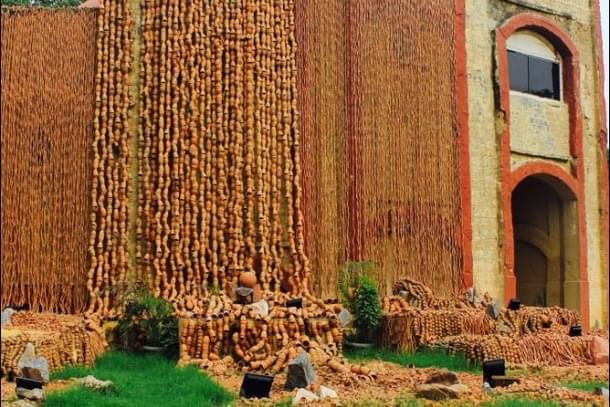
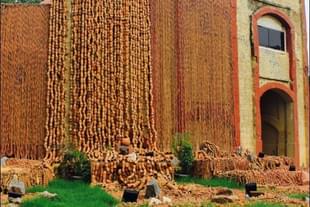
A few years ago, at a display of Delhi-based artist Manav Gupta's works in Minneapolis, visitors asked him if earthen lamps would survive the snow. Gupta uses clay objects in his body of work, where he embraces nature and architecture. Earthen lamps - his ingredient for the persistent in-depth probe into nature through gigantic installations, were making viewers curious. Gupta’s love for clay, especially the earthen lamp, is deep. So, to quell all doubts regarding life and longevity of clay, he left ‘Shrinking River’, one of the installation works, in Minneapolis snow.
Clay, mud, maati - the steel of Indian art history - lies fairly unexplored in public art and other display avenues. Gupta's work brings it back, from earth to art. He says, "it is a myth that clay cannot stand tough conditions, or that it is perishable. When I left the 'Shrinking River' in snow, people were surprised. They understood my belief in clay. They understood clay and its permanence, the fragility of life, our belief in nature and elements as sacred." He adopted clay as his medium, extensively, in 2013.
No other artist uses clay and pottery in public art like Manav Gupta. His works on nature and climate change are extensive, in harmony with themes and sites he chooses, and soul stirring. In the back drop of the recent Kerala floods, his series, ‘Arth’ (meaning), stands as the most gentle and revolutionary expression of art exposed to rain, trees and sunlight. Depletion of natural resources, recreating and sustaining, are at the core of the series.
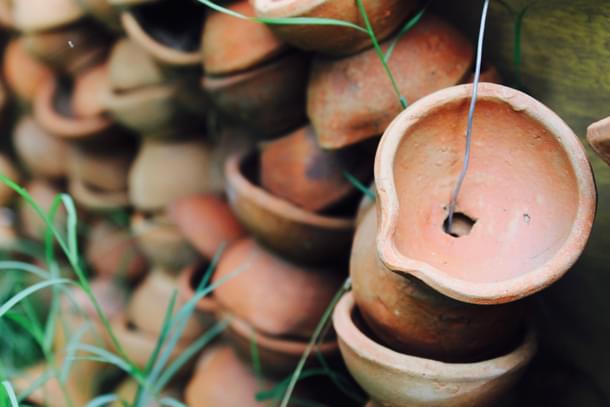
At the ongoing exhibition of his works at the grounds of Delhi's Indira Gandhi National Centre for the Arts (IGNCA), stands ‘Ganga the Riverfront and Matighar’, his tribute to Ganga. The work flows, suspended from the roof top of Matighar the iconic art gallery. It presents a striking depiction of the sacred river in its various flows and stages. "In my view, it is a perfect synergy and tribute to Matighar, which has been closed. The Ganga will lose out if we do not care for it. Concern and activism towards the environment doesn't have to be noisy. I chose to raise my concern by recreating the river and by engaging with people in mega cities." He adds, "my first experience of exhibiting a river depicted in pottery outside India was in South Africa. People there were alien to the idea of diyas and what they are about."
Mimicking nature is an art. Gupta uses clay and deploys seemingly mundane objects of pottery - diya (the earthen lamp), chilum (smoking pipe), khullhad (cup) and ghara (pot) to create rain, waterfronts and rain forests, and other aspects of nature and life. He weaves and assembles the clay objects into installation works in painstaking efforts to mimic nature and to arrive at nature - as closely as he can.
Why clay? "We are clay. Maati. Dust to dust. Hence, clay. I am clay." Art is about hope. Offering earthen lamps to people in public art, Gupta hopes that people will not discard diyas, which serve as a "conduit of prayer to the sacred”. Clay is a representative of an element. "It represents earth and human," he says, "we deplete our resources and we are depleting human kind."
There is more to his choice of material. Metaphors. He is unearthing them through simple objects made of clay. "I am scrubbing the soul," he says. To him, the first realisation of using clay as a drop came from an inverted diya. "There are artists who can create from cerebral thought. For me, it has to be in the heart, the inside. It (clay) kept growing inside."
Watching Gupta's ‘Waterfront’ for the second time in Delhi (it was displayed first a few years ago), unravels more depth and details in his work. The presence of clay in several strings of diya, chilum and khullhad woven together to form a river and installed at Matighar, involves a layer of meanings. "It is my tribute to Matighar, which translates into an abode of mud, through my work."
The use of the different shapes and sizes of the numerous diya, chilum and khullhad and gharas used in the "waterfront" gives it a sense of flow. The chilum lends it the cascade, diyas the flow, kullhads - the break in the flow - pace and momentum, and pots - the gurgle, hollows and rocks. Gupta is aware of the ripples of emotions the 'Waterfront' creates in the viewer. "Maano to Ganga, Na maano to behta paani (it's all in the perception - of Ganga as Ganga or Ganga as flowing water)," he says.
Gupta relies on architecture and nature to produce installation works out of material, which, if not meticulously blended into his philosophy and thought, would mingle in surroundings - as any other mundane clay object meant for use, as dust. In his art work, these objects become more than mere 'useful' kiln-burnt pieces of utility. They acquire meaning. They become grains of a flow - moments in a story and chapters in Arth, the continuing series of works dedicated to nature and environment. They transform into remnants of an element, beaded together. Assembled together, woven into various patterns with the help of thin wires and knots. "Weaving happens differently. For softer flow, I use chilum," he adds.
In order to connect rivers, people, rain forests and other aspects of nature and life through works of installation that are global in language and Indian in soul, he is required to drop something in particular, regularly. "The pedestal (of high art and perceptions and activism associated with high art)." It is relieving to see his art at a healthy distance from a couple of aspects. First - the elitist approach of looking at nature in language and art work. Second - the piercing cacophony of activism. He believes in simplicity.
Time Machine, Beehive Garden, the Noah’s Ark, the Bed of Life are built around metaphors. He wanted to give a message. "The humble clay can serve as luxury.” He adds, “I was surprised to see people at a mall, where my works were displayed, connecting with the works. Similarly, at the most premium addresses in mega cities. People were surprised. They were not sitting at cafes. They were looking at the river. You've got to engage the audience right. I believe in people's intelligence." He pays attention to viewers' perception.
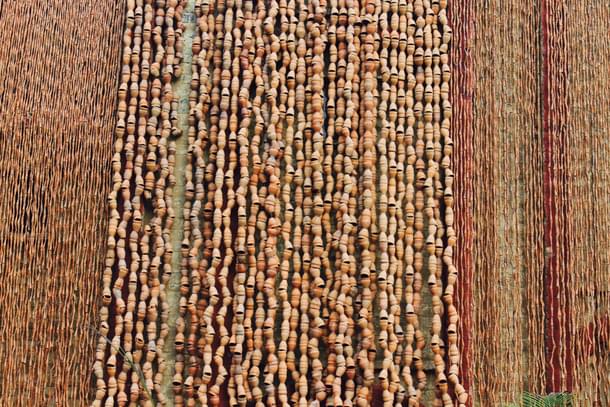
At the IGNCA lawns, Gupta's installations have spent a monsoon - out in the open, under sun, rain, night and day. Clay - maati - his medium for art in Arth develops a warm relationship with the site. "It had to be intrinsic. It had to be Indian. Clay was me." Gupta describes himself as "non conformist". He adds, "I have never been in a market-driven exercise (when it comes to works in clay)." He lingers between, around and outside the works, like a protagonist, director and narrator on a unique stage. He is ever present in the continuing drama of a "micro ecosystem" flourishing around his art work and the trees.
Clay talks to the other four elements present at the site in his site specific work in Arth, the series he has pursued over the decades. Its prototypes are housed in his studio in Delhi. The prototypes remain there. The traveling museums (collection of his works) interact with the world and venues. He adds, "Foreign audience is much more impressed, eager and far ahead in terms of wanting the works. As always, it so happens, we (Indians) realise our worth much later."
Rain, his work comprising chilum -the traditional smoking pipe of clay associated with intoxication - strung meticulously into thin wires, succeeds in creating a poetic depiction of rain. The viewer can feel the flow of drops. The pitter-patter is tapped in a drenching fall in the remarkable use of one element to depict another. Clay for water. Diyas arranged most cleverly on wires define the sense of play in his own understanding of rain and its geometry. "Each strand is important. Each string is important," he adds.
He catches the flow in broken geometry. He arrives, very close in his work, at the inner texture of the falling rain. It is understood and experienced best when one walks through the strings of clay chilum falling from tree branches. It is while standing between the falling wires studded with the chilum when Gupta's fine handling of the most simple activity in nature and season, that of rain, arises distinctly. The effect is similar to what a viewer would experience when he sees an object kept between parallel mirrors. This, in particular, is more intoxicating than any intoxication associated with the chilum itself. "I tell my viewers - get drenched in the rain of chilum," he says.
It is fascinating how his work grows and develops for months after he has put up the installations - out in the open. "Trees are my laboratory", he says. Gupta has used fallen trees for sculptures in the past. In the current display, the falling of rain in Rain from tree branches has a symbolic significance. Rain needs trees, and trees rain.
Rain invites life. Worms, insects, birds, creepers, climbers, and seedlings, live and play on and around this installation. Around Bee Hive - another installation. Around the Bed of Life, yet another installation that symbolises the concept of bed as bedrock of love, life, death. Around Ganga - the Waterfront, which symbolises the scared river, and the flowing of time. And then, there is Noah's Ark, the intriguing piece in the thought chain and cycle.
Human presence is pleasant disturbance. Parakeets fly in and out of the Beehive Garden project - one of the most fulfilling works. Parakeets leave feathers behind as temporary mementos on clay on the beehives. The cuckoo continues the dialogue with trees. Other birds visiting the trees discuss their daily lives, swinging on the raindrops of clay in ‘Rain’, once in a while. Crows grumble nesting issues. Ants walk their own little miles on sun dried rain-soaked diyas and moss-curled clay curves.
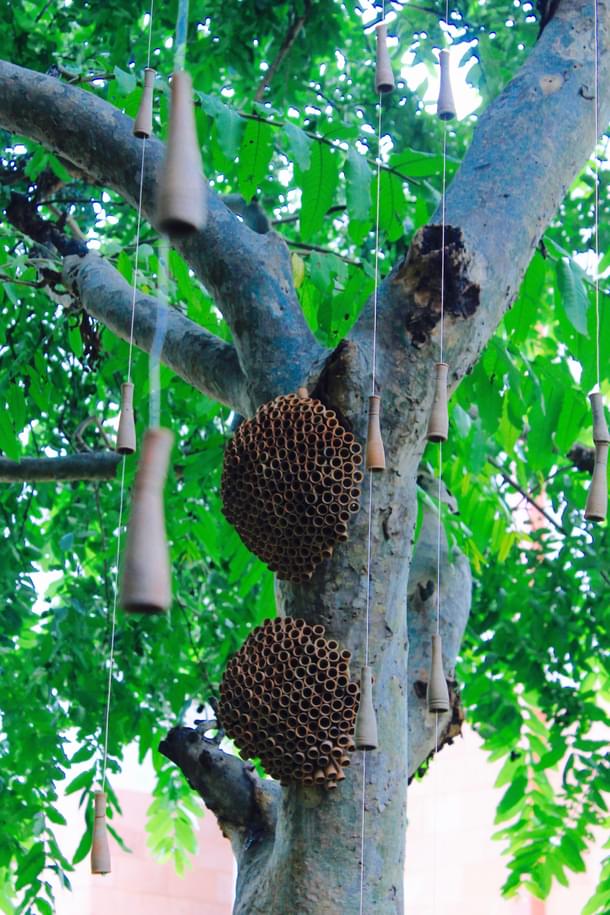
The beehives are honey sweet punctuation on trees. They display workmanship, thought, patience, control precision and form. Kulhads - in every work - become the cups of life. He says, "It was very difficult to arrive at the most natural depiction of aspects of nature in general and the beehives in particular. For me, it was important that the form of the beehive remains as natural as possible. The larger beehives just followed. A beehive can turn artificial very easily and quickly. One has to be careful."
Gupta tells Swarajya the reason behind using Arjuna and neem trees for this museum (collection of his works). "Arjuna and neem trees are being lynched for their medicinal values. They have to be nurtured. It is a reverse process. We have to nurture trees and, therefore, rain," he adds.
The act of weaving, beading, threading knotting, tying untying, assembling dismantling - the fundamental fabric of Indian textures, lives and traditions, is the basis of his unique use of clay. Nature begins to twine around the numerous units of clay in his work. But clay, the medium, itself, remains detached and unnerved by continuing activity around it. It stands in the music of bird song and rain.
He has to dismantle "each and every unit" for the travelling museum. The reassembling of the units swirls up a new cycle of recreation every time, every display, every site. Earth to art to metaphor and back. “Dust to dust”. No one uses baked clay for public art like Manav Gupta and nothing scrubs the soul better than clay.
(Pictures by Sumati Mehrishi)
Sumati Mehrishi is Senior Editor, Swarajya. She tweets at @sumati_mehrishi





